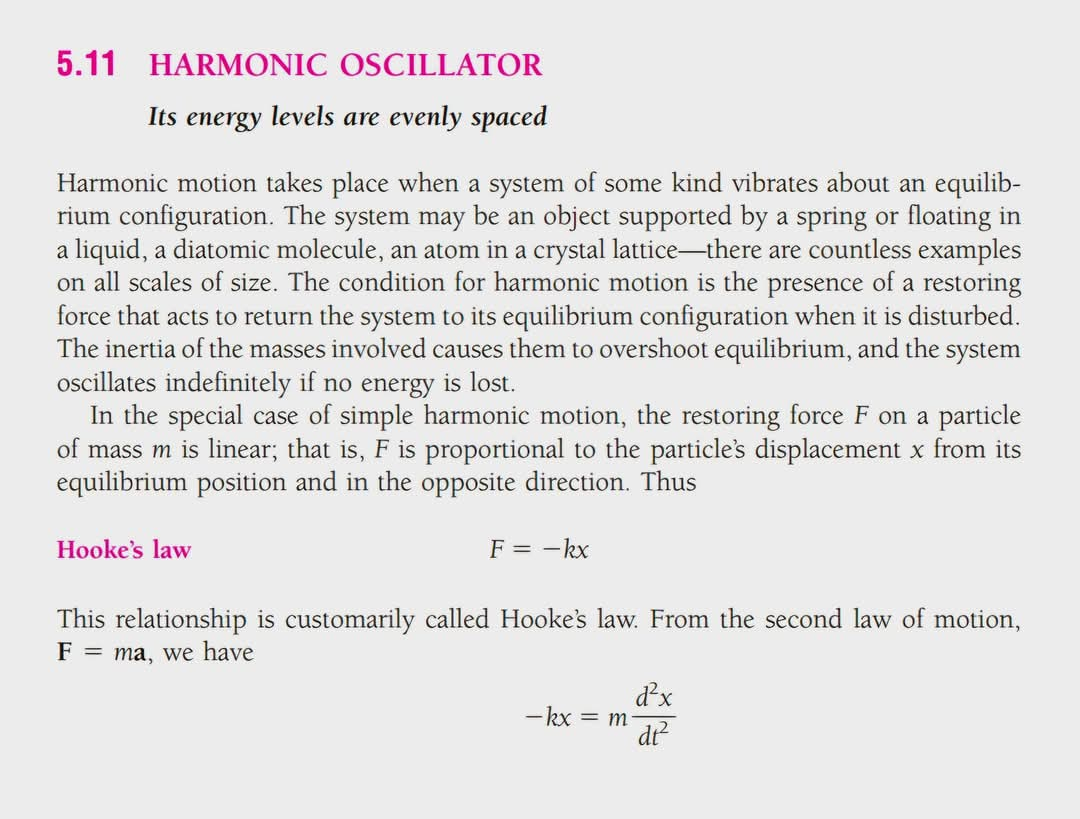단순 조화 운동(Simple Harmonic Motion)과 후크의 법칙(Hooke's Law)
단순 조화 운동(Simple Harmonic Motion)과 후크의 법칙(Hooke's Law)을 설명하는 물리학 교재의 한 페이지를 보여줍니다. 핵심 내용은 다음과 같습니다.
1. 단순 조화 운동의 정의:
단순 조화 운동은 어떤 시스템이 평형 위치를 중심으로 진동하는 운동입니다. 예시로 용수철에 매달린 물체, 액체 속에서 떠 있는 물체, 이원자 분자, 결정 격자 내의 원자 등이 언급되어 있습니다. 이러한 운동의 조건은 시스템이 외부 힘에 의해 평형 위치에서 벗어났을 때, 평형 위치로 되돌리는 복원력(restoring force)이 존재하는 것입니다.
2. 후크의 법칙:
단순 조화 운동의 특별한 경우로, 복원력 F가 질량 m의 입자의 평형 위치로부터의 변위 x에 비례하고, 방향은 반대인 선형적인 경우를 설명합니다. 이 관계는 후크의 법칙으로 알려져 있으며 다음과 같이 표현됩니다:
F = -kx
여기서 k는 용수철 상수(spring constant)입니다.
3. 운동 방정식:
뉴턴의 제2운동 법칙 (F = ma)을 적용하여, 단순 조화 운동의 운동 방정식을 유도합니다. 질량 m에 작용하는 힘 F가 -kx이므로, 다음과 같은 미분 방정식을 얻습니다:
-kx = m(d²x/dt²)
이 미분 방정식은 단순 조화 운동을 기술하는 기본 방정식입니다. 이 방정식의 해는 시간에 따라 사인파 또는 코사인파 형태의 진동을 나타냅니다.
요약:
이미지는 단순 조화 운동의 개념, 후크의 법칙, 그리고 이를 이용한 운동 방정식 유도를 간결하게 설명하고 있습니다. 이는 물리학, 특히 역학 분야의 기본적인 개념을 다루고 있습니다.

The image shows a page from a physics textbook explaining Simple Harmonic Motion and Hooke's Law. Here's a breakdown of the key points:
1. Defining Simple Harmonic Motion:
Simple Harmonic Motion is a type of oscillatory motion where a system vibrates about an equilibrium position. Examples given include an object attached to a spring, an object floating in a liquid, a diatomic molecule, and an atom within a crystal lattice. The condition for this motion is the presence of a restoring force that acts to return the system to its equilibrium configuration when it's disturbed.
2. Hooke's Law:
A special case of Simple Harmonic Motion is when the restoring force F acting on a particle of mass m is linear; that is, F is proportional to the particle's displacement x from its equilibrium position and acts in the opposite direction. This relationship is known as Hooke's Law and is expressed as:
F = -kx
where k is the spring constant.
3. Equation of Motion:
Applying Newton's Second Law of Motion (F = ma), we can derive the equation of motion for Simple Harmonic Motion. Since the force F acting on mass m is -kx, we obtain the following differential equation:
-kx = m(d²x/dt²)
This differential equation is the fundamental equation describing Simple Harmonic Motion. Its solution represents an oscillation that varies sinusoidally or cosinusoidally with time.
Summary:
The image concisely explains the concept of Simple Harmonic Motion, Hooke's Law, and the derivation of the equation of motion using the law. This represents a fundamental concept in physics, particularly in mechanics.